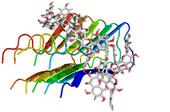Highlight
Molecular Modeling to Improve Drug Design
Achievement/Results
Professor David Bevan and graduate students Justin Lemkul and William Allen in the Department of Biochemistry are using cutting-edge computer simulations to aid in developing therapeutics for neurological disorders including Parkinson’s and Alzheimer’s diseases. The researchers are using molecular dynamics (MD) simulations to explore interactions between proteins, enzymes, and small molecules. Experiments have shown that a protein in the brain (amyloid beta-peptide) unfolds and aggregates ultimately killing neurons and leading to Alzheimer’s disease. Flavonoids, a class of antioxidant compounds present in red wine have been shown to break up these protein aggregates, but the mechanism by which this occurs is unclear. MD simulations carried out by Justin are providing details regarding the nature of interactions between amyloid beta-peptide and flavonoids that are inaccessible to most experimental techniques. This information could lead to production of effective therapeutic agents for the treatment of Alzheimer’s disease. Monoamine oxidase B is an enzyme that has been implicated in Parkinson’s disease. William is using a technique called steered molecular dynamics to identify compounds that may effectively inhibit this enzyme and could therefore be effective Parkinson’s therapeutics. The virtual screening process can narrow the search for effective drugs from thousands of potentially effective compounds to tens of compounds. These computer simulation techniques provide valuable information related to drug development and save time and money in the drug design process.
Address Goals
This research will provide valuable data regarding the interactions between important large and small molecules involved in neurological disorders. The data may facilitate drug design by advancing the understanding of the role of these molecules in diseases and how therapeutic agents could be most effective. This research will provide valuable information that can be applied to early intervention strategies for preventing neurological disorders. This research helps to bridge the gap between computer simulations and laboratory benchtop research, ultimately increasing scientific understanding and cross-disciplinary communication.







